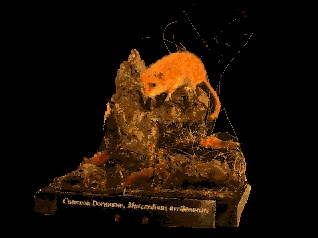
|
Common Dormouse, Muscardinus avellanarius Suborder Sciurognathi The feet are prehensile and very flexible, making this animal a good climber: most of its time is spent above ground. The diet consists of flowers and pollen, fruits, nuts and insects; they are the only rodents that do not have a caecum - they eat little cellulose. Unusually, they have four cheek teeth in each row with a unique pattern of transverse ridges. Premolars are present (dental formula: I 1/1, C 0/0, P 1/1, M 3/3) and all cheek teeth are rooted. |







